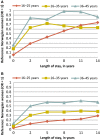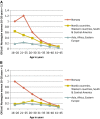Use of hormonal contraceptives among immigrant and native women in Norway: data from the Norwegian Prescription Database
- PMID: 24931487
- PMCID: PMC4282112
- DOI: 10.1111/1471-0528.12906
Use of hormonal contraceptives among immigrant and native women in Norway: data from the Norwegian Prescription Database
Abstract
Objective: To examine the use of hormonal contraceptives among immigrant and native women in Norway.
Design: Nationwide registry-based study based on merged data from the Norwegian Prescription Database, the Norwegian Population Registry, the Regular General Practitioner Database and the Medical Birth Registry.
Setting: Norway.
Sample: All women born abroad to two foreign-born parents (immigrants), or born in Norway to two Norwegian-born parents (natives) aged 16-45 years, who lived in Norway in 2008.
Methods: Data on all collected supplies of hormonal contraceptives in 2008 were merged with demographic, socio-economic and immigration data, information on any delivery and women's general practitioners.
Main outcome measures: User rates of hormonal contraception and predictors of contraceptive use.
Results: A total of 893,073 women were included, of whom 130,080 were immigrants. More native women (38%) used hormonal contraceptives compared with all immigrant groups (15-24%). The odds ratios for any use of hormonal contraceptives for immigrants compared with Norwegian-born women were; Nordic countries 0.53, South and Central America 0.53, Western countries 0.39, Asia 0.30, Eastern Europe 0.29, Africa 0.29. Work, education, long stay in Norway and young age of immigration predicted the use of hormonal contraceptives among immigrants.
Conclusions: The use of hormonal contraceptives varies between natives and immigrant groups. Further work is needed to ascertain whether these differences can be explained by higher desires for fertility, preferential use of non-hormonal contraceptives or other reasons identified through qualitative research.
Keywords: Contraceptive agents; family planning; immigrant women; prescription database.
© 2014 The Authors. BJOG An International Journal of Obstetrics and Gynaecology published by John Wiley & Sons Ltd on behalf of Royal College of Obstetricians and Gynaecologists.
Figures


Comment in
-
Re: Use of hormonal contraceptives among immigrant and native women in Norway: data from the Norwegian Prescription Database: The contraceptive situation in Korea.BJOG. 2016 Apr;123(5):840. doi: 10.1111/1471-0528.13830. BJOG. 2016. PMID: 27149353 No abstract available.
Similar articles
-
Use of hormonal contraceptives among immigrant women and their daughters in Norway: Data from the Norwegian Prescription Database.Acta Obstet Gynecol Scand. 2019 Feb;98(2):232-239. doi: 10.1111/aogs.13469. Epub 2018 Oct 31. Acta Obstet Gynecol Scand. 2019. PMID: 30252134 Free PMC article.
-
Utilization of somatic specialist services among psychiatric immigrant patients: the Norwegian patient registry study.BMC Health Serv Res. 2018 Nov 13;18(1):852. doi: 10.1186/s12913-018-3672-y. BMC Health Serv Res. 2018. PMID: 30424757 Free PMC article.
-
Re: Use of hormonal contraceptives among immigrant and native women in Norway: data from the Norwegian Prescription Database: The contraceptive situation in Korea.BJOG. 2016 Apr;123(5):840. doi: 10.1111/1471-0528.13830. BJOG. 2016. PMID: 27149353 No abstract available.
-
[Tuberculosis and immigration in Spain: scoping review].Rev Esp Salud Publica. 2014 Nov-Dec;88(6):803-9. doi: 10.4321/S1135-57272014000600011. Rev Esp Salud Publica. 2014. PMID: 25418569 Spanish.
-
[Health inequalities in immigrant populations in Spain: a scoping review].Rev Esp Salud Publica. 2014 Nov-Dec;88(6):687-701. doi: 10.4321/S1135-57272014000600003. Rev Esp Salud Publica. 2014. PMID: 25418561 Spanish.
Cited by
-
What factors influence a Quality Improvement Collaborative in improving contraceptive services for foreign-born women? A qualitative study in Sweden.BMC Health Serv Res. 2023 Oct 11;23(1):1089. doi: 10.1186/s12913-023-10060-2. BMC Health Serv Res. 2023. PMID: 37821891 Free PMC article.
-
Developing contraceptive services for immigrant women postpartum - a case study of a quality improvement collaborative in Sweden.BMC Health Serv Res. 2022 Apr 26;22(1):556. doi: 10.1186/s12913-022-07965-9. BMC Health Serv Res. 2022. PMID: 35473622 Free PMC article.
-
Primary healthcare usage and morbidity among immigrant children compared with non-immigrant children: a population-based study in Norway.BMJ Open. 2016 Oct 13;6(10):e012101. doi: 10.1136/bmjopen-2016-012101. BMJ Open. 2016. PMID: 27737883 Free PMC article.
-
Use of hormonal contraceptives among immigrant women and their daughters in Norway: Data from the Norwegian Prescription Database.Acta Obstet Gynecol Scand. 2019 Feb;98(2):232-239. doi: 10.1111/aogs.13469. Epub 2018 Oct 31. Acta Obstet Gynecol Scand. 2019. PMID: 30252134 Free PMC article.
-
Co-designing postpartum contraceptive services with and for immigrant women in Sweden: lessons learned from the IMPROVE-it project.BMC Health Serv Res. 2024 Oct 31;24(1):1325. doi: 10.1186/s12913-024-11709-2. BMC Health Serv Res. 2024. PMID: 39482733 Free PMC article.
References
-
- United Nations Population Fund. By choice, not by chance. In: Kollodge R, editor. State of World Population Reports. United Nations Population Fund; 2012. [ www.unfpa.org/public/publications/swps ]. Accessed 26 September 2013.
-
- Department of Reproductive Health WHO. Medical Eligibility Criteria for Contraceptive Use. Geneva: WHO; 2009. 4th edn [ www.who.int/reproductivehealth/publications/family_planning/978924156388... ]. Accessed 26 September 2013.
-
- Van Vliet HA, Grimes DA, Lopez LM, Schulz KF, Helmerhorst FM. Triphasic versus monophasic oral contraceptives for contraception. Cochrane Database Syst Rev. 2011:CD003553. - PubMed
-
- Srikanthan A, Reid RL. Religious and cultural influences on contraception. J Obstet Gynaecol Can. 2008;30:129–37. - PubMed
MeSH terms
Substances
LinkOut - more resources
Full Text Sources
Other Literature Sources

